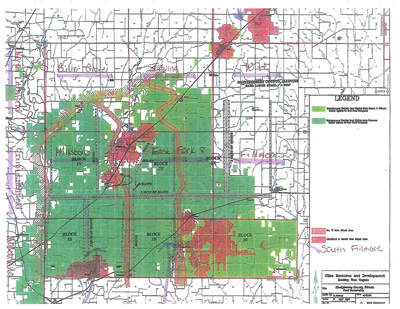There will be no hearing in October.
On September 1, 2015, IDNR Hearing Officer Jack Price filed his response to yet another Motion from the Bailey & Glasser Deer Run Coal Mine attorneys, Kim Fladhammer and Elizabeth Dow, and dismissed the case!Â
BACKGROUND:
Five petitioners filed for the State Administrative Review of Significant Revision No. 1 in November of 2012, and through two hearing officers, umpteen delays and dismissal motions from coal attorneys, Cathy Edmiston remained as the only petitioner to carry the case with her attorney, David Wentworth, with Hasselberg Grebe Snodgrass Urban & Wentworth.
From June 22-23, 2015, Edmiston and experts for her case, Chuck Norris and Jack Spadaro, were on the stand before Hearing Officer Jack Price, but this was only part of the evidence hearing.  The second part of the hearing where experts called by the mine were to present evidence and be cross examined never happened even with June 24, 2015 scheduled for the hearing.  IDNR/mine experts, Scott Fowler and Dan Barkley, were to follow Edmiston’s experts.  Those two IDNR staff members were to answer questions about Significant Revision No. 1 of Permit 399. Hearing Officer Price scheduled the hearing to resume on August 5, 2015 when Fowler and Barkley would be on the stand and subject to cross examination.
Fladhammer filed on July 17, 2015  a request for rescheduling the August 5, 2015 hearing stating that her husband was having surgery on August 6th and she was needed  “for an extend period of time post-surgery while her spouse is unable to drive.†Price approved the motion and rescheduled the hearing to October 14, 2015.
There was a very curious series of events before Price dismissed the case on September 1, 2015.  On July 9, 2015, Price issued his response to a Motion filed by the mine on June 23, 2015, the last day of the Petitioner’s evidence presentation. Price affirmed that Edmiston had standing and denied the mine’s attempt to dismiss her. Price did agree with the mine that the issue of the Design of the Impoundment Structure, “is the type of structure contemplated by the rules, and is within the parameters defined by the rules,†so that issue was dropped from the case.
Price stated on the third issue, that
“The Petitioner has shown, and Intervener agrees, [what] currently exists is a coal mine waste impoundment structure. The only evidence before me at this time is that, without being dewatered, it will remain an impounding structure after reclamation and this is prohibited by the rule. It appears from the permit application and both testimony and questions during this hearing and argument made to support this Motion, that the intent is to convert the impoundment area into wildlife habitat during the reclamation, without removing or breaching the dam and without dewatering. Petitioner’s attorney argues this is not permitted, and cites to 62 IAC 1817.84 b) 1) which clearly states the structure may not be retained permanently as part of the approved post-mining land use.  As no evidence has been offered (as yet) that the structure may be retained, I find that Petitioner has met her burden of showing at least temporarily, that the reclamation plan is in violation of the administrative rule. Motion to Dismiss the issue of reclamation as it applies to the impoundment structure is DENIED.†Â
That was on July 9, 2015. What happened between July 9, 2015 and Price’s contrary decision on September 1, 2015?
On July 20, 2015, Price approved extending the hearing to October as requested by Fladhammer. Â Due to vacation and other commitments IDNR staff and the other attorneys were not available until then.
On July 31, 2015, Fladhammer filed “Hillsboro Energy LLC’s Motion to Reconsider Order of July 9, 2015†which was basically yet another attempt to get the case dismissed. In it she asked Price to reconsider his rulings on the earlier oral motion to dismiss the case, giving the same reason as earlier, “for failure to state a claim upon which relief can be granted.†This was the same issue that Fladhammer had filed in June on the last day of the presentation of Edmiston’s experts. In her July 31, 2015 filing, Fladhammer states in section  ‘Argument III’ that the Petitioner  has presented all of her evidence and the matter is set to recommence only to hear Hillsboro’s evidence. She then went on to claim, “there has been no evidence as to the amount of damage – i.e., whether any such pollution would exceed state and federal standards of allowable pollution,†that would occur as a result of the issuance of this Permit. She went on to say the Petitioner has the burden of establishing her damage at the evidentiary hearing, “including the burden of proving her allegation that pollution would exceed the state and federal standards of allowable pollution.† Fladhammer also listed that there was no evidence of any “actual or imminent†damage.
Wentworth filed a response on August 6, 2015. He pointed out that Hillsboro Energy, “recklessly cites to an unreported Federal District Court opinion on the requirement of an ‘actual or imminent injury’ for Article III in Fladhammer’s Motion to Reconsider. He pointed out that no other new point is raised for reconsideration. He also pointed out this is a state case and has nothing to do with federal court jurisdiction, and affirmed that the Hearing Officer’s decision of July 9, 2015 regarding standing under Illinois law is correct.
In a surprise turnaround, Hearing Officer Price changed his previous responses regarding the sole remaining Petitioner, Cathy Edmiston, and on September 1st, decreed that,
“I further find that Intervener [the mine] is correct in the assertion that Petitioner must show actual damage, and such damage must be beyond the bounds of the damage permitted by government agencies. While I have little doubt that Petitioner’s land will, more likely than not, eventually be polluted by waste from Deer Run Mine, a certain amount of waste pollution is allowed by law, and there was no evidence that any pollution will probably exceed such allowance†and he GRANTED the Fladhammer Motion to Reconsider in its entirety, and stated, “this matter is therefore DISMISSED.â€
What the Hearing Officer missed was the entire point of the case, which is the contents of the coal slurry impoundment are still wet, and will continue to have rain and moisture infiltrate through the dirt and coarse coal refuse “cap†after it is full of residue. And at some point the liner will leak, and the sand lenses known to be scattered underground where the high existing water table will produce a huge pollution problem for future generations.
Ironically, the mine’s claim that there was no evidence provided to determine the amount of damage or whether any such pollution would indeed exceed state and federal standards, was factual since a prior ruling of Price disallowed analyses of water samples taken during an onsite inspection by Norris and Spadaro on July 24, 2014.  The outcome of the Administrative Review was unfortunately determined by what evidence was allowed to be submitted.   Â
Administrative law can certainly be abused and the rulings unjust.  The result is that IDNR’s regulatory authority validates its own permits to the demise of coalfield citizens and the environment.  The way that an Administrative Review is conducted in Illinois substantiates some of the issues discussed in Philip Hamburger’s book, “Is Administrative Law Unlawful?â€
As the title of this article states, the disappointing end to the Administrative Review of the Significant Revision No. 1 of Permit 399 was the second time that petitioners’ concerns did not receive the rule of law. There never was an Administrative Review of Permit 399 although there were many petitioners who struggled to get facts, evidence and expert testimony before a hearing officer. Under IDNR Hearing Officer Michael O’Hara, there were delays and nearly a year of an extended hiatus.
The Permit 399 Administrative Review was finally taken over by Hearing Officer Robert Welch after nearly a year of inaction.  On October 31, 2013, Welch dismissed the case based on a Motion from the mine regarding the failure of the Petitioner’s attorney to file certain documents by the required dates. This was complicated by the fact that Welch never recognized that the previous Hearing Officer O’Hara had declared the dates in the case were on hold until an issue of Sanctions filed against the Petitioners be resolved. IDNR had filed a Motion for Sanctions with threats of monetary penalties and other potential legal actions against the citizens and their attorney on December 23, 2010. Welch did not respond to the IDNR Sanction Motion nor did he even officially approve the 2011 request by the Petitioners to recognize a substitute attorney until September 26, 2013.  Remarkably, this was already after the date the mine cited for failure to respond which was what led to the dismissal ruling.  This procedural exercise in futility lasted 4 1/2 years, from March, 2009 to October 31, 2013.
The outcome is a longwall mine in the city of Hillsboro, Illinois that will be forever blight to the community with damage to health, threats of impoundment failure and leakage, contamination of water resources, and subsidence of farmland and roads.Â
Hearing Officer Jack Price Response to Motion to Dismiss


